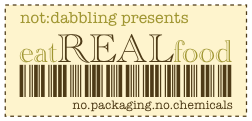This last weekend I purchased a bushel of Fuji apples. One of my absolute favorite apples. Ever. My intent was to store them in our cool basement since they’re such good keepers. (For a good list of apple varieties and their qualities visit pickyourown.org)
Instead I’ve been going mad for baked apple goodness. Sunday I made these:

Apple dumplings that are knock-your-socks-off good. The key to such a good flavor was the boiled cider – also known as apple molasses – that I made. Just a little bit imparts an amazingly intense flavor. Sure you could buy it online and have it shipped, but if you have the opportunity you should try to make it, especially if you can get local apples!
So because I couldn’t get enough of that yumminess, I had to make something more…. but better for me.
Enter Apple Dumpling Oatmeal.
I prepared this last night before bed in 15 minutes, and it was ready to go for me this morning. You could alternatively prepare this in a dutch oven, or on the stove top if you don’t care to leave a crockpot plugged in all night. I’ve given you three options! Just bring your appetite. This is a stick-to-your-ribs kinda meal. The kind that makes you want to get outside and get something done. That, or help yourself to seconds…

Apple Dumpling Oatmeal
Makes 6-8 LARGE portions
- 2 medium cooking apples, peeled, cored, and diced
- 1-1/4 cups steel cut oats or thick rolled oats
- 4 cups water
- 1 rounded tsp boiled cider (lick the spoon!)
- pinch salt
- 1 Tbsp butter
- 1/4 cup sugar (brown, raw, or sucanat), honey, or syrup
- 1/2 cup raisins, dried cranberries or cherries (optional)
- 1/4 cup chopped walnuts or pecans (optional)
- (if you don’t have access to boiled cider, substitute 1 cup cider for 1 cup water, then get to the store and pick up some cider and boil it!)
Dutch oven:
Preheat oven to 400F. Meanwhile add ingredients to dutch oven on the stove top, bringing them just to a boil. Cover and put in oven. Immediately turn off oven. In the morning you may need to add some liquid in the form of milk or water, and to reheat on the stove just a bit.
Stove top:
Add ingredients to medium saucepan, and bring to a boil over medium high heat. Cover tightly and lower heat to medium-low, stirring occasionally. It’s done when your oats are soft and apples are no longer firm.
Crock Pot:
Add ingredients to crock pot and turn on low. Let cook at least 6 hours. Stir gently before serving.

Top with a drizzle of fresh cream(and maybe some maple syrup) and enjoy it while it’s still warm!
***
You can find Jennifer at Unearthing This Life where she’s currently focusing on autumn and homeschooling.












 Set your own limits. What is acceptable to you? Would you be willing to spend a couple of Saturdays at the end of summer to put up the products of a good harvest? Can you fit an hour a week into your plans to go to the farm stand or market instead of the grocery store? Is it really okay to purchase organic garlic from Argentina, when you can wait until fall and pick it up locally? Can you get by with eating foods grown strictly in your own country? Would you be willing to eat seasonally and regionally instead of buying out of season fruits and vegetables from California? What ingredients would you be willing to give up, grow yourself, or purchase locally instead of having them imported? Would you be willing to be an activist and get the ball rolling on a local farmers market?
Set your own limits. What is acceptable to you? Would you be willing to spend a couple of Saturdays at the end of summer to put up the products of a good harvest? Can you fit an hour a week into your plans to go to the farm stand or market instead of the grocery store? Is it really okay to purchase organic garlic from Argentina, when you can wait until fall and pick it up locally? Can you get by with eating foods grown strictly in your own country? Would you be willing to eat seasonally and regionally instead of buying out of season fruits and vegetables from California? What ingredients would you be willing to give up, grow yourself, or purchase locally instead of having them imported? Would you be willing to be an activist and get the ball rolling on a local farmers market?





